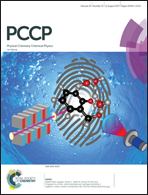Non-invasively improving the Schottky barriers of metal–MoS2 interfaces: effects of atomic vacancies in a BN buffer layer
Abstract
Using first-principles calculations within density functional theory, vacancies in the BN buffer layer have been predicted to improve the Schottky barrier of the metal–MoS2 interface without deteriorating the intrinsic properties of the MoS2 layer. Here, the effects of concentrations, sizes and types of vacancies on the contact properties of metal/BN–MoS2 sandwich interfaces are comparatively studied. The results show that vacancies in the BN buffer layer not only don't deteriorate the charge scatterings and electronic properties of the MoS2 layer at the metal/BN–MoS2 interface, but also improve the charge density and contact resistance between the metal surface and the BN layer. Although these vacancies have a negligible influence on the Fermi level pinning effect of the metal/BN–MoS2 interface, both N-vacancies and B-vacancies significantly change the position of the Fermi level of the metal/BN–MoS2 interface and then tune the Schottky barriers. Moreover, the Schottky barriers of metal/BN–MoS2 interfaces can decrease at first with the increasing concentrations and sizes of vacancies. When the concentration of vacancies increases to 4%, the Schottky barriers of metal/BN–MoS2 interfaces can reduce to the minimum value. The lowest n-type and p-type Schottky barriers of Au/BN–MoS2 and Pt/BN–MoS2 interfaces can reduce to −0.16 and 0.28 eV, respectively. However, the Schottky barriers are deteriorated when the sizes and concentrations of vacancies continue to increase because vacancies with large sizes and concentrations obviously change the interfacial structures of metal/BN–MoS2 interfaces and disarrange the directions of interface dipoles. The predictions in this work provide a non-invasive method to achieve high performance metal–MoS2 interfaces with low Schottky barriers.



 Please wait while we load your content...
Please wait while we load your content...